Japan
Wood Products Prices
Dollar Exchange Rates of 25th
Oct
2022
Japan Yen 149.1
Reports From Japan
New economic
package to prevent economic downturn
In an effort to help struggling households and companies,
especially small enterprises, cope with inflation the
government has arranged a new economic package worth
39 trillion yen (US$264 billion) focusing on steps to ease
the pain of higher prices passed on to households, spurring
wage growth and preventing any economic downturn after
the modest recovery from the pandemic.
Securing enough funding is a challenge for heavilyindebted
Japan whose debt has ballooned to more than
twice the size of the economy.
The recent surge in inflation is attributed to higher energy
and raw material costs, most of which are imported at
sharply higher prices because of the weak yen exchange
rate. Many commentators say the inflationary pressures
have been made worse by the Bank of Japan's (BoJ)
monetary easing policy. Core consumer inflation exceeded
3% in September, the sharpest gain since 1991 but still
well below that in other similar economies
See:
https://english.kyodonews.net/news/2022/10/dc19f0bc7937-japan-eyes-26-tril-yen-economic-package-to-fight-inflation.html
Inflation weighing on business confidence
The BoJ Tankan survey showed major manufacturers are
still much more upbeat than during the gloomiest days of
the Covid-19 pandemic. But inflation, including higher
energy prices fueled by the war in Ukraine, has weighed
on business confidence this year.
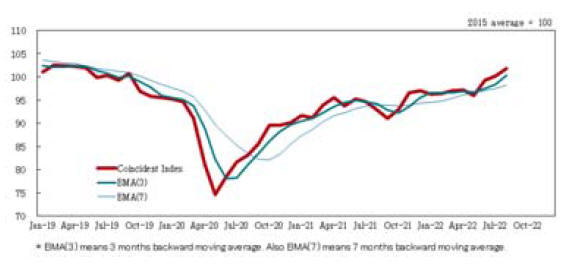
Japan Green Investment for Carbon Neutrality
The national broadcaster NHK has reported on the
establishment of the Japan Green Investment Corp. for
Carbon Neutrality (JICN). This is a joint initiative by the
Japanese government and private sector that will provide
investments and loans for decarbonisation projects.
Environment Minister Nishimura Akihiro attended its
inaugural general meeting and said he hopes the
organisation will actively and boldly provide funds for
decarbonisation projects without being bound by
precedents. The JICN will provide investment and debt
guarantees for projects such as renewable energy, plastic
recycling and forest conservation. The government,
financial institutions and businesses have invested a total
of 20.4 billion yen in JICN. The organisation is headed by
Tayoshi Yoshihiko.
See:
https://www3.nhk.or.jp/nhkworld/en/news/20221028_39/
and
https://www.env.go.jp/en/press/press_00704.html
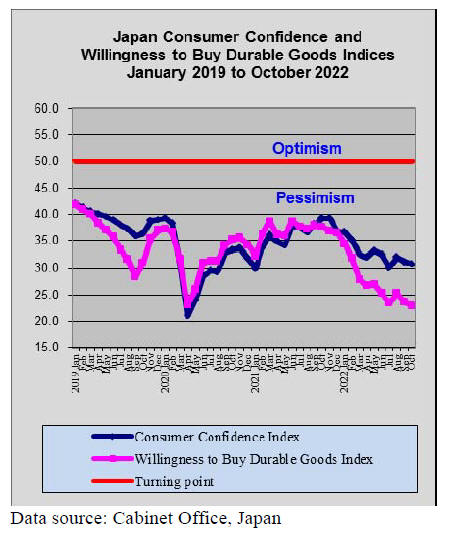
Yen in free fall
The BoJ remains committed to its ultra-low interest rates
arguing that raising interest rates under the current
economic conditions would only undermine the already
weak demand. This month the yen fell to a 32-year low
against the US dollar.
The BoJ governor, Haruhiko Kuroda, made it clear when
speaking to law makers that the bank has no plans to
change course.
See:
https://www.nytimes.com/2022/10/21/business/japaninterest-rates.html
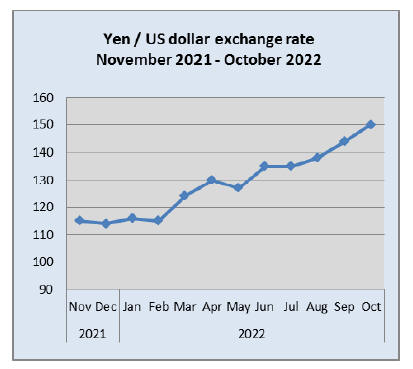
Real estate prices back to 20-year highs
The real estate market in Japan is seeing a surprising
upswing on the back of the cheap yen and a revival of
interest in investment in property. The yen has fallen 20%
against the US dollar which has lifted demand from
foreign real estate investors.
The country’s house price index peaked in the first quarter
of 1991, a prelude to the end of the Japanese asset price
bubble. This led to what became known as a “Lost
Decade” where the economy stagnated and prices
deflated.
This was in part caused by Japan’s decision to
raise interest rates above 6% which caused an evaporation
of liquidity from the market and prices to tumble. Today,
prices are back to 20-year highs.
See:
https://capital.com/japan-house-price-crash-foreigninvestment-weak-yen

Import update
Assembled wooden flooring imports
Despite the drop in the value of imported assembled
wooden flooring (HS441271-79) in July and the only
modest 3% upswing in August, year on year up to August
2022 imports rose 17%.
HS441875 was the main category of flooring imported in
August (as it was in previous months) accounting for 78%
of the total. In August, China was the main supplier of
HS441875 at 50% followed by Vietnam 21% Austria 11%
and Malaysia 10%.
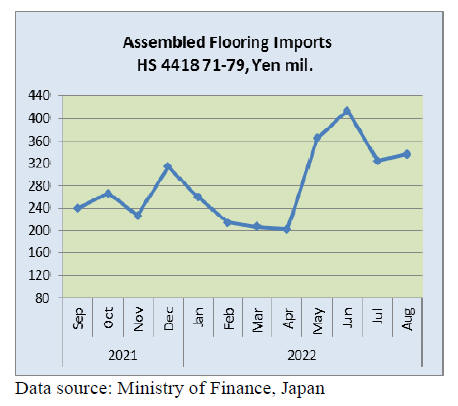
Plywood imports
August imports of plywood (HS441210-39) stood at 172.8
cu.m, down 5% from the previous month but up 20% on
August 2021. Indonesia and Malaysia are the main
suppliers of plywood to Japan and together they accounted
for around 77% of Japan’s August import volumes.
Shipments from Malaysia were down in August compared
to July but shipments from Indonesia were up month on
month. Compared to the volumes imported in August
2021 both Malaysia and Indonesia saw gains this year.
Plywood imports from China at 19,000 cu.m were down
compared to July but up on August 2021. In contrast,
plywood imports from Vietnam rose both month on month
and year on year in August this year.

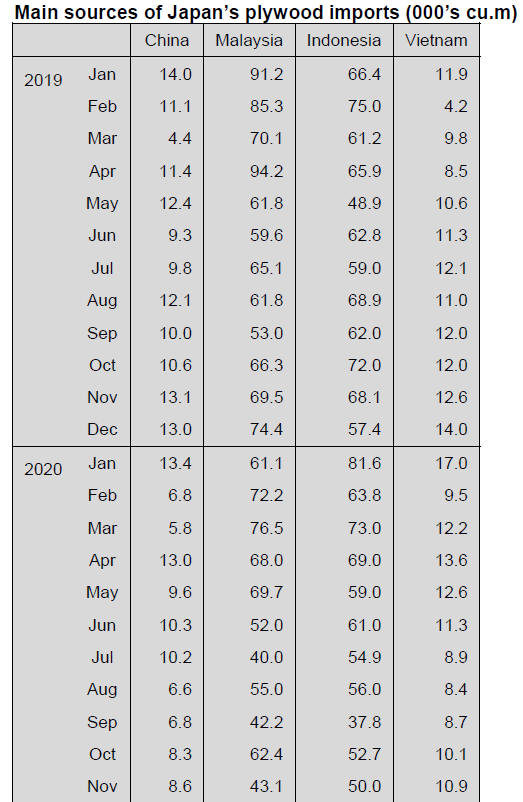 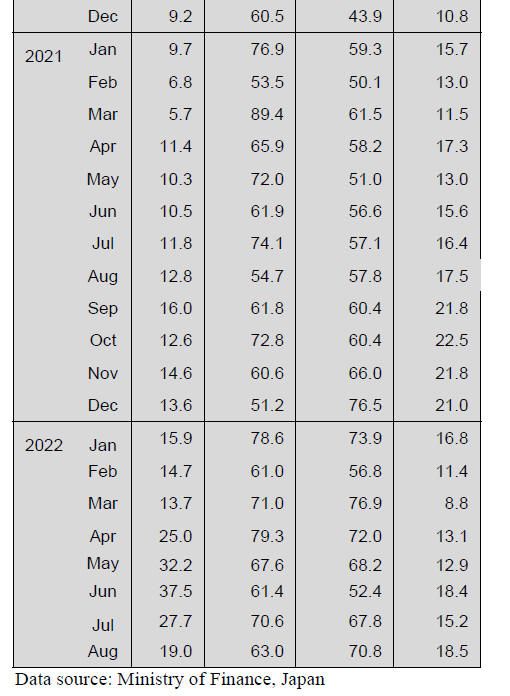
Trade news from the Japan Lumber Reports (JLR)
The Japan Lumber Reports (JLR), a subscription trade
journal published every two weeks in English, is
generously allowing the ITTO Tropical Timber Market
Report to reproduce news on the Japanese market
precisely as it appears in the JLR.
For the JLR report please see:
https://jfpj.jp/japan_lumber_reports/
Domestic softwood plywood
Domestic softwood plywood manufacturers start to adjust
production because there are not many inquires due to
excessive inventory. Volume of the inventory at the end of
August was 0.5 month, 0.4 month more than previous
month, against the volume of shipment.
This was low-level volume and manufacturers think that
0.7 month is a standard volume. Volume of softwood
plywood produced in August was 235,804 cbms, 8.6% less
than July due to the holidays in the middle of August.
Shipment was 223,652 cbms, 11% less than previous
month and inventory at the end of August was 111,495
cbms, 11.9% more than previous month.
This production was almost same volume as May’s
production but shipment was 7.2% less than May. This
was for the first time of a low-level shipment volume in
two years.
Inventory at the end of September will increase because
wholesalers and precutting plants do not get the softwood
plywood due to interim budget results in September.
Once, the inventory increased to 178,798 cbms at the
end
of May, 2020 due to the COVID -19 but it does not have
to reduce the inventory at this time.
Since Japanese government banned importing veneers
from Russia and there is a manufacturer which stopped
producing softwood plywood due to the fire broke out.
However, the prices of 12mm 3 x 6 are 2,000 yen,
delivered per sheet, and this is over double priced
compared to 2020.
Usually, demand for plywood is very lively during
September to the end of the year and a movement of
shipment is high-level. It might be a shortage of softwood
plywood by reducing production but manufacturers do
reduce production to keep the prices in same level.
It is unclear how much volume and what kind of plywood
would be reduced but manufacturers would shorten a time
of operations or working days. Most of manufacturers start
reducing production in October but some of them had
already started. There is no time limit and it depends on a
situation whether to increase production or not.
Wood demand and supply in 2021
A total volume of demand and supply in 2021 is
82,132,000 cbms, 10.3% more than 2020. This is the
increase for the first time in three years.
For domestic production, this is straight twelve years
increase. Volume of structural lumber including plywood
is stabilizing and of fuel wood increased a lot for the past
five years.
Volume of fuel wood increased by 39.1% from 2020 and a
rate of self -sufficiency in wood decreased 41.1%, 0.7
point lower than 2020 due to increased imported wood.
This is decrease for the first time in eleven years.
A total supply of structural lumber is 3,647,000 cbms,
8.8% higher than previous year and of non-structural
lumber is 45,660,000 cbms, 11.6% higher than previous
year. It is obvious that these results are on the rebound
from 2020 when the total starts decreased over 10% due to
the COVID-19.
Supply of domestic lumber is 33,720,000 cbms, 8.3%
higher than 2020 and this is straight twelve months
increase.
Imported lumber is 4,840 cbms, 11.8% higher than 2020
and this is for the first time in three years growing. This is
because imported wood fuel grew for 40% up from 2020.
Volume of imported lumber decreased due to the wood
shock in 2021 and a rate of self-sufficiency in structural
lumber is 48%, 0.8 point more than last year.
Average of supply volume during 2012 – 2016 was
75,000,000 cbms and the supply volume increased to
80,000,000 cbms during 2017-2021.
Domestic and imported lumber are levelling off since
2016. However, wood fuel in 2016 was 5,810,000 cbms
and increased to 14,740,000 cbms in 2021, 153% more
than 2016. Grand total of housing starts and wood fuel
after the Lehman shock in 2008 have been increasing.
The rate of self-sufficiency in wood grew to 41% in 2020
from 26.3% in 2010. Nevertheless, the imported wood fuel
in 2021 increased 40% from the previous year and the rate
of self-sufficiency in wood decreased by 0.7 point.
Domestic unused wood has been used for wood biomass
power generation plants since the FIT (Feed in Tariff) had
started in 2012. Volume of domestic wood fuel have been
increasing for twelve years continuously.
Now, the imported pellets are used for large wood biomass
power generation plants instead of domestic wood fuel, so
wood fuel in 2021 increased 1,520,000 cbms, 39.1% from
3,880,000 cbms in 2020.
Since housing starts decreased 10% in 2020 due to the
COVID- 19, all kinds of supply volume increased in 2021.
Starts of wooden house in 2019 were 520,000 units and
starts in 2021 were 500,000 units.
A rate of self-sufficiency in lumber in 2019 was 46.3%
and 48% in 2021. Plywood was 45.3%.
South Sea lumber
Demand for South Sea lumber is sluggish in Japan but the
prices in Japan are high because the export prices in South
Asia are high and the yen is continuing to fall against the
dollar.
Movement of lumber from Europe or Russia in Japan is
slow due to the excessive inventory. However, there is not
enough inventory of South Sea lumber for interior
finishing lumber. The weak yen is also a problem. It was
145 yen against the dollar at the end of September.
The Japanese government and the Bank of Japan intervene
in currency markets to stop the yen falling but the yen will
continue falling due to a large difference in interest rates
between the U.S.A. and Japan. That is why distribution
companies have to raise the prices even though the
movement is slow and they are not rush for selling.
Laminated lumber manufacturers in China and Indonesia
occasionally lower the prices a little bit.
|